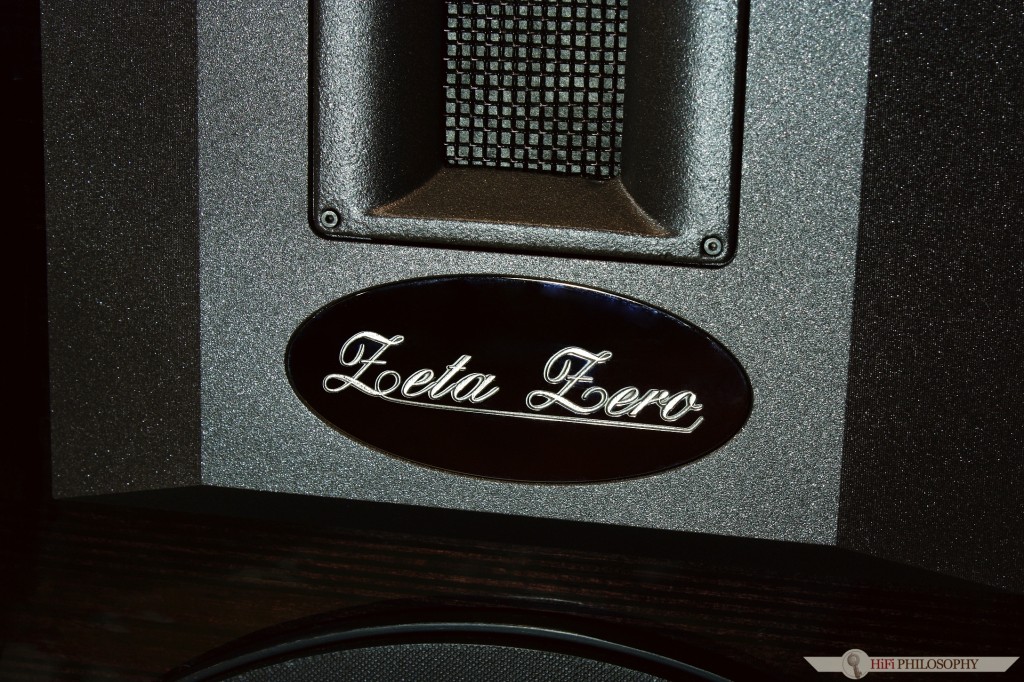 Polska wersja recenzji/Polish version of this review
Polska wersja recenzji/Polish version of this review
Tomasz Rogula is my fellow countrymen. We had both grown up in Cracow during the same period of time. And although we had never met before, fate has brought us together now, when he had been living in Warsaw for years and I had returned to Cracow after years. Both of us have submersed ourselves in the field of music, he being consciously there and remaining very active from his earliest childhood, and I, as most of us, was only an outside consumer. The only active part on my behalf was playing the guitar in my teenage years. Currently I am a reviewer and Tomasz is a true expert in the Polish audiophile and music industry. He is both an owner of a magnificient recording studio TR STUDIOS and also a producer of the widely known Zeta Zero loudspeakers along with their power end bits, preamplifiers and the whole cable system. He has been presenting his achievements annually at the Warsaw Audio Show and every time he provides a real show, not only a static display. Numerous audience can have the opportunity to compare his sound system including preamplifier and amplifier to a few others, whose contents account for the highest quality analogical components of the most recognized brands. As reult, the TR Studios stall is a place where undoubtedly the most action takes place (during the Audio Show) and bluntly said, the only place where you can compare things directly, and not only listen to let’s say analog records, CDs, or just computer files. One day I will write more about those comparisons because they are very revelating – possibly on the basis of the upcoming next year’s show – and for now let us focus around particular loudspeakers being the subject of this review.
TR Studios and Zetas
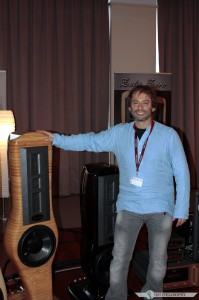 TR Studios, meaning Mr Tomasz Rogula’s recording studio, ia an important ingredient of the Polish music scheme, it is a place where most known music stage artists as well as the masters of a spoken word proceed with their recordings. Working at such a place is surely a wonderful experience and it is excellent for finding optimal sounds which most successfully combine emotional advantages of the sound with the great exactness of its production and replaying from the technical point of view. That is not an easy task because the battle between emotional layer and so called musicality with a precise, analytical grasping of sound material appearing suddenly on the verge of attempts to obtain possibly best dramaturgy and tune along with efforts to pass the most meaningful message, has been carried on since the very beginning of musical recordings technology and applies equally to both analog and the digital sphere.
TR Studios, meaning Mr Tomasz Rogula’s recording studio, ia an important ingredient of the Polish music scheme, it is a place where most known music stage artists as well as the masters of a spoken word proceed with their recordings. Working at such a place is surely a wonderful experience and it is excellent for finding optimal sounds which most successfully combine emotional advantages of the sound with the great exactness of its production and replaying from the technical point of view. That is not an easy task because the battle between emotional layer and so called musicality with a precise, analytical grasping of sound material appearing suddenly on the verge of attempts to obtain possibly best dramaturgy and tune along with efforts to pass the most meaningful message, has been carried on since the very beginning of musical recordings technology and applies equally to both analog and the digital sphere.
There were opposite Vectors like the usual happenings during war. Analog recording was smooth, it could precisely express emotions and musical atmosphere, however it suffered a lack of information related to the morphology of physical modeling and what is more, it was poor when it came to the durability of a sound carrier. The digital one, on the other hand, could gather large amounts of independent bits, as well as artifically multiply them by the method of interpoling. It could also store and copy given material without any damage, however it lacked that smooth analog flow and it constantly faced so called steps. Although those issues apply mainly to what happens to the sound, still being an electromagnetic wave, before it reaches the speaker’s converter. But it is not the only issue. All problems with conversion and recording eventually fall upon those converters and they had to somehow convert those imperfections into possibly the best picture of live music, being at the opposite end of the signal.
And so the truth is, that it was within the loudspeakers themselves where the final clash would take place between not precise enough analog smoothness and a jagged bit.
 Some loudspeakers are more musical and others are more analytical, which can be easily checked by connecting them interchangibly to the same path. The most crucial aspect here is to balance the proportions, as for no one should assume that a speaker would only be connected to analog paths, or only to those focused on analysis. As an effect, a good loudspeaker should fall in between and should be able to combine apects which are really not possible to combine; not fit for one another from the very start, or somehow disabled. It has to be a synthesis of musicality without analysis, and at the same time be analysis lacking musicality, for such is the practice and the reality of life itself. Of course both contemporary record players as well as digital CD and file players strive to achieve perfection as is electromagnetic wave perfectly modeling live music; but let us not deceive ourselves – already the fact that the best recordings exist as archival imperfections, means that there will be constant problems while playing music. We will take a closer look at the part devoted to hearing and see how Zetas manage to combine the flow with analysis. For now, we will focus on the technical side of the issue.
Some loudspeakers are more musical and others are more analytical, which can be easily checked by connecting them interchangibly to the same path. The most crucial aspect here is to balance the proportions, as for no one should assume that a speaker would only be connected to analog paths, or only to those focused on analysis. As an effect, a good loudspeaker should fall in between and should be able to combine apects which are really not possible to combine; not fit for one another from the very start, or somehow disabled. It has to be a synthesis of musicality without analysis, and at the same time be analysis lacking musicality, for such is the practice and the reality of life itself. Of course both contemporary record players as well as digital CD and file players strive to achieve perfection as is electromagnetic wave perfectly modeling live music; but let us not deceive ourselves – already the fact that the best recordings exist as archival imperfections, means that there will be constant problems while playing music. We will take a closer look at the part devoted to hearing and see how Zetas manage to combine the flow with analysis. For now, we will focus on the technical side of the issue.
Structure
 All Zeta loudspeakers look similar in their outside appearance and all of them were based on the same technical solution. At the top there is a triple ribbon loudspeaker section designed and manufactured by the same company and only for its own usage, at the bottom there is a single subwoofer being a remastered and improved version by an outside manufacterer. Its membrane is made of carbon fiber. As a result every Zeta is narrower and slimmer in the upper part, and wider at the bottom, which, along with a slight narrowing in the middle, gives them a sensual, feminine shape, subconsciously stimulating your imagination.
All Zeta loudspeakers look similar in their outside appearance and all of them were based on the same technical solution. At the top there is a triple ribbon loudspeaker section designed and manufactured by the same company and only for its own usage, at the bottom there is a single subwoofer being a remastered and improved version by an outside manufacterer. Its membrane is made of carbon fiber. As a result every Zeta is narrower and slimmer in the upper part, and wider at the bottom, which, along with a slight narrowing in the middle, gives them a sensual, feminine shape, subconsciously stimulating your imagination.
It finds its reflection in the name itself, for it was called Venus, directly relating to a woman’s beauty captured by paleolitical sculptors. In this reference to the human bodily beauty not only shape of the sillouette matters, but also the fact that the whole case is free from any sharp edges, it gently angles from one surface to another. According to the producer it is also supposed to remind one of the shape of musical instruments, and what is most important, the way the sound spreads on objects, which is more pleasurable for the listener while being free from any interference and difractions of parallel surfaces and sharp drops.
From the finishing point of view, the manufacturing work is a masterpiece and its polish finishing fulfills all demands. It allows its owner to submerse into luxury in its highest form. No MDF or plywood were used. All cases are made from multiple layers of solid wood connected with screws and glue, where the former ones are screwed under specific angle and the latter was of a very special kind. Just like in the old days, the ship makers making ships, similarly nowadays carpenters working for Zeta have to provide the wooden structure with a smooth shape through proper profiling and careful matching of connecting surfaces, as to make it freely move through the waves. In the first example meaning sea waves and in the second, sound waves.
 Consequently the process of making cases is very time consuming taking into consideration the fact that wood needs to be seasoned and the polish has to properly dry. All of that is ensured by a special carpenter shop while Tomasz focuses strictly on the loudspeakers themselves. He has been focusing on them for the last ten years, as it is the length of time that was needed for research and developmental stage of the Zeta program. Loudspeakers obtained as a result of that, are even more extraordinary than their cases, making them one of a kind. Triple section of ribbon converters covering the whole band above the lowest tones is entirely Zeta’s solution, which no one else has ever been able to obtain so far, and the company itself, despite very lucrative offers has not agreed to share its patents to anyone. There is some very advanced technology behind the project, and it is based on vacuum generating of composites, being many times stronger than aluminium, from which usually ribbon membranes are made. Using the ribbons themselves is not in any case coincidental, for they are considered to be the fastest in sending impulses and almost entirely free from any acoustic disproportions out of all models of loudspeaker’s membranes. Thanks to the proper material technology Zeta’s ribbons are also very resistant to any damage both mechanical, and thermal, so that their future owner does not have to worry about their accidental damage by applying too strong of a signal or some kind components’ failure. In addition to that the user also gets an unusual acoustic converter, the only one of such kind in the world, which allows for obtaining the widest ever spectrum free from distortions. The extent of advancement of this triple channel ribbon loudspeaker can be supported by the fact that it consists of over five hundred elements, among which one can find those being worldly unique, and a product manufactured in a high vacuum conditions of a space technology kind. The completion of ribbons is a single high force subwoofer, which is capable of carrying the lowest frequencies with high effectiveness and a proper power. Only in the most advanced structure of the Edition model it is accompanied by an extra middletone loudspeaker.
Consequently the process of making cases is very time consuming taking into consideration the fact that wood needs to be seasoned and the polish has to properly dry. All of that is ensured by a special carpenter shop while Tomasz focuses strictly on the loudspeakers themselves. He has been focusing on them for the last ten years, as it is the length of time that was needed for research and developmental stage of the Zeta program. Loudspeakers obtained as a result of that, are even more extraordinary than their cases, making them one of a kind. Triple section of ribbon converters covering the whole band above the lowest tones is entirely Zeta’s solution, which no one else has ever been able to obtain so far, and the company itself, despite very lucrative offers has not agreed to share its patents to anyone. There is some very advanced technology behind the project, and it is based on vacuum generating of composites, being many times stronger than aluminium, from which usually ribbon membranes are made. Using the ribbons themselves is not in any case coincidental, for they are considered to be the fastest in sending impulses and almost entirely free from any acoustic disproportions out of all models of loudspeaker’s membranes. Thanks to the proper material technology Zeta’s ribbons are also very resistant to any damage both mechanical, and thermal, so that their future owner does not have to worry about their accidental damage by applying too strong of a signal or some kind components’ failure. In addition to that the user also gets an unusual acoustic converter, the only one of such kind in the world, which allows for obtaining the widest ever spectrum free from distortions. The extent of advancement of this triple channel ribbon loudspeaker can be supported by the fact that it consists of over five hundred elements, among which one can find those being worldly unique, and a product manufactured in a high vacuum conditions of a space technology kind. The completion of ribbons is a single high force subwoofer, which is capable of carrying the lowest frequencies with high effectiveness and a proper power. Only in the most advanced structure of the Edition model it is accompanied by an extra middletone loudspeaker.
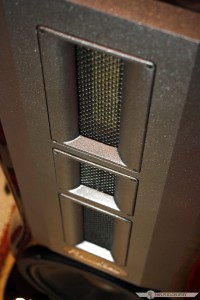 It is a curious and an interesting fact that the loudspeakers, similarly to a passenger or an army plane are equipped with their own black boxes which register their parameters of work, thus allowing to read the conditions in which they were used. What is more, they also have active cooling systems and anti overload protection, putting it in brief, it would be very hard to damage them without an axe or a chainsaw. The producer himself foresaw, that they would require their own amplifiers of nominal strength as high as 5 kW (provided that two monoblocks are used per each channel). To sum it up, it is sooner that your house electrical instal will be damaged than the loudspeaker itself. On top of all those advantages there is also a smooth high tone adjustment nob hidden in the bass reflex channel, and it allows to tune them accordingly to induvidual tastes, or connecting in a bi-wiring way, which is known to be better than the standard one. As if that was not enough the company offers their own loudspeaker cables as an addition to the loudspeakers themselves. Cables, which consist of over eight thousand twisted silver wires. And, it is given free of charge.
It is a curious and an interesting fact that the loudspeakers, similarly to a passenger or an army plane are equipped with their own black boxes which register their parameters of work, thus allowing to read the conditions in which they were used. What is more, they also have active cooling systems and anti overload protection, putting it in brief, it would be very hard to damage them without an axe or a chainsaw. The producer himself foresaw, that they would require their own amplifiers of nominal strength as high as 5 kW (provided that two monoblocks are used per each channel). To sum it up, it is sooner that your house electrical instal will be damaged than the loudspeaker itself. On top of all those advantages there is also a smooth high tone adjustment nob hidden in the bass reflex channel, and it allows to tune them accordingly to induvidual tastes, or connecting in a bi-wiring way, which is known to be better than the standard one. As if that was not enough the company offers their own loudspeaker cables as an addition to the loudspeakers themselves. Cables, which consist of over eight thousand twisted silver wires. And, it is given free of charge.
The Venus Series includes three models each of whom is manufactured in four different finishings – Mahogany, Sand of Sahara, Black, and Transparent. Models differ in shape of the lower part and the position of a subwoofer in case of the highest model Edition, with a different strength and, as I have mentioned before, additionally supported by a middletone loudspeaker.
The Sound
With ASL Twin-Head and Croft
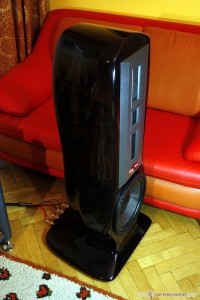 I have beagun the research from my own system. TheTwin-Head preamplifier and the Croft Polestar1 strength end bit powered by the Cairn. I used the original cable for if it is sold, it should technically fit. I am not sure whether we can call it optimal but it should definitely be very appropriate.
I have beagun the research from my own system. TheTwin-Head preamplifier and the Croft Polestar1 strength end bit powered by the Cairn. I used the original cable for if it is sold, it should technically fit. I am not sure whether we can call it optimal but it should definitely be very appropriate.
As per usual I started with the sliding and there is not much to say in this matter. It is good if you can place Zetas at least one meter away from the wall behind them but if there is no such possibility it will not be the end of the world. It is important, however, that the listener be positioned precisely at the point where the loudspeakers’ facing lines cross, because, unlike other speakers, Zetas do not like facing straight ahead, they defenitely prefer to look straight at the listener. They also like a carpet to be spread in front of them, and the Piccola model tested here had not objections against its front legs being gently elevated, provided that we do not listen from a far distance away.
As for the distance, the loudspeakers (at least in my case) were not prone to filling the whole room with sound, which can be concluded from the fact that they wanted to face the listener directly. They created a certain sound area spreading far to the back and more less the same distance in the front, and my belief is that it is very conveninet to be able to stand within that area, which can be called the area of an active influence. In that position contact with music becomes somehow very direct. Saying it in other words, in the household listening conditions, in a room of about 20 meters square size it is good to sit about 1,5-2,5 meters away from th speakers because if we sit further away it will make us more of a viewer that a direct participant.
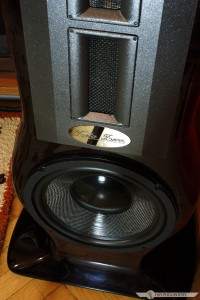 After taking a comfortable seat and making sure that the back of an armachair is above the level of your ears (which provides good reflecting, also in case of AKG K1000 headphones), I began to indulge myself in sound. At first it was a bit difficult because I still carried last year’s Audio Show Zetas in my head (this year I did not listen so eagerly) and my memory told me that back then there was a better sound. Nevertheless I did not make any changes and continued allowing music to flow and patiently awaiting changes. For I have my own theory, completely undocumented but proving true in practice, that the equipment has to get to know themselves in a way, by being played for a while. Sometimes it takes a few days, sometimes less. In case of Zetas it took about four hours. Maybe is is simply the result of the listener’s ear accomodation and not the loudspeakers’ membranes communicating with the signal, however I have not got the slightest doubt that after a few hours (during which I did not listen constantly), the scene clearly gained its debth and became organized, and the sounds became more beautiful. When that happened, I could experience wonderful musical encounters because the way Zetas play is a real masterpiece and there is no doubt about it. Apart from that, they own that very particular and worth paying attention feature, mainly their high volume levels are fantastic. I usually do not listen to music very loudly. At the Audio Show I often ask for music to be turned down and when I take part in an audiophile meeting it proves, that others listen to much louder sounds. But here I let myself go for it and turned it up. Zetas can manage the decibel tunami in an excellent way while allowing you to enjoy the power of either a symphonic orchestra, or a rock concert. They do not demonstrate even a trace of control loss, not mentioning harmonic distortions, and maintain an excellent scenic order throughout the whole time.
After taking a comfortable seat and making sure that the back of an armachair is above the level of your ears (which provides good reflecting, also in case of AKG K1000 headphones), I began to indulge myself in sound. At first it was a bit difficult because I still carried last year’s Audio Show Zetas in my head (this year I did not listen so eagerly) and my memory told me that back then there was a better sound. Nevertheless I did not make any changes and continued allowing music to flow and patiently awaiting changes. For I have my own theory, completely undocumented but proving true in practice, that the equipment has to get to know themselves in a way, by being played for a while. Sometimes it takes a few days, sometimes less. In case of Zetas it took about four hours. Maybe is is simply the result of the listener’s ear accomodation and not the loudspeakers’ membranes communicating with the signal, however I have not got the slightest doubt that after a few hours (during which I did not listen constantly), the scene clearly gained its debth and became organized, and the sounds became more beautiful. When that happened, I could experience wonderful musical encounters because the way Zetas play is a real masterpiece and there is no doubt about it. Apart from that, they own that very particular and worth paying attention feature, mainly their high volume levels are fantastic. I usually do not listen to music very loudly. At the Audio Show I often ask for music to be turned down and when I take part in an audiophile meeting it proves, that others listen to much louder sounds. But here I let myself go for it and turned it up. Zetas can manage the decibel tunami in an excellent way while allowing you to enjoy the power of either a symphonic orchestra, or a rock concert. They do not demonstrate even a trace of control loss, not mentioning harmonic distortions, and maintain an excellent scenic order throughout the whole time.
 As for the stage, as I have mentioned, the sound travels a few good meters back behind the louspeakers and similarly it comes towards the listener. Within that area no sounds escape upwards, everything is kept in hand at the proper level and there is a perfect museum-like order.
As for the stage, as I have mentioned, the sound travels a few good meters back behind the louspeakers and similarly it comes towards the listener. Within that area no sounds escape upwards, everything is kept in hand at the proper level and there is a perfect museum-like order.
The Sound
With ASL Twin-Head and Croft cont.
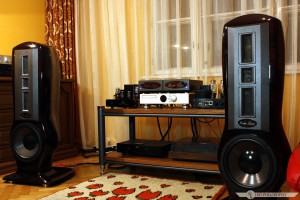 As a matter of fact the comparison which I made is not exactly perfect because museum-like order suggests statics and deadliness, and with Zetas it is exactly the opposite. The sources are not only located with an excellent precision but at the same time, they very much communicate with one another so that sounds clearly cooperate overlapping one another and creating multi-dimentional monolith of the sound slab. Actually it is ideal because that is what it exactly should be.
As a matter of fact the comparison which I made is not exactly perfect because museum-like order suggests statics and deadliness, and with Zetas it is exactly the opposite. The sources are not only located with an excellent precision but at the same time, they very much communicate with one another so that sounds clearly cooperate overlapping one another and creating multi-dimentional monolith of the sound slab. Actually it is ideal because that is what it exactly should be.
As for the sounds themselves, they were not softened, overstretched or gluey. Neither were they cold ot simplified. In a natural sense they were exact. They had proper temperature, right filling and appropriate weight. No over-heaviness and no over-smoothing. Those Zetas were filled with an ideal sound vis centrifuge giving the sounds proper weight and exapansion pace. Obviously, experiments with the spinning loudspeakers conducted in the past allowed Mr Tomasz to achieve the right propagation of sound and same measure of its weight. For the sound should neither be rumbling as potatoes poured out of the sack, nor should it be light as a butterfly. It has got to have a chance to be fast and maintain properly harmonic, rich shape. It is all hard to obtain and rarely all those three parameters together can hold the highest quality. Zetas did not have problems in that aspect, however they created a problem for others, for the fact, that it will be hard for others to repeat something like that. Their speed is a feature naturally belonging to the ribbon loudspeakers, just as the beauty of sopranes. But as for the mass it is not so, or not even near. In the meantime all three Zeta ribbons managed to hold proper mass without slightest difficulty, and what is more, they provided sounds with excellent shaping. However, that excellence was expressed by naturality and not warmth, cheesiness or over-thickening of the sound.
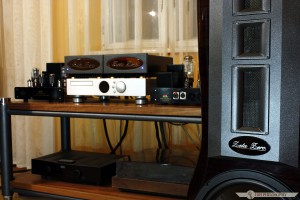 It was a tube stage but apart from the elegancy of sound tubes could not be felt. I cannot really say whether I prefer tube’s trickiness, or its naturality, because I like them both. In this case it was certainly a demonstration of tube naturality but, as per usual, when tubec work in stage that certain grace appeared, untracable by transistors; grace which was much more difficult to obtain by them. Transistors jump up high on a dynamic scale but tubes move much more smoothly. And music is not some type of sports high jump contest, or at least not only.
It was a tube stage but apart from the elegancy of sound tubes could not be felt. I cannot really say whether I prefer tube’s trickiness, or its naturality, because I like them both. In this case it was certainly a demonstration of tube naturality but, as per usual, when tubec work in stage that certain grace appeared, untracable by transistors; grace which was much more difficult to obtain by them. Transistors jump up high on a dynamic scale but tubes move much more smoothly. And music is not some type of sports high jump contest, or at least not only.
All righ now, enough for those generalizations. The sound produced by Zetas was also big, strong, saturated and deep. At the same time it was quite tight at the beginning but as the time passed it was becoming more elastic. Particular attention, however, was brought by noticeable size of sources. Not overwhelming, but rather large. Zeta is called Zero and it gives zero miniaturization. Instruments and voices presented by it are large, sturdy and strong.
On top of those Zetas I have placed famous Entreqa mice, which are source of hysterical fury attacks amongst enemies of celebrated audiophilism. Whatever the cause of the rage could be, those mice have their own purpose. So far I have tried them with two sets of loudspeakers and every time it was identical. They make the sound harder, more explicit and more expressive. It has turned out not to match well with Audio Solution loudspeakers but with Zetas the effect was very interesting. Although the sound without mice was more vibrating and various as audiophiles would call it, it was better to listen with mice and every time I tried removing them, I felt like placing them back right away. My son had a similar feeling, adding mice gives such an effect as if a drum was much better tuned. I will write about the mice some other time after I gain more knowledge about them based on numerous tests.
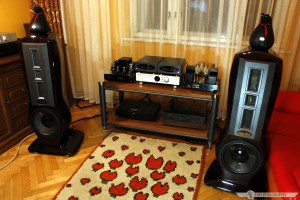 Apart from all that, the sound of Zetas in my stage was slightly dimmed, which matched it in an excellent way, thus creating more interesting truly concert-like atmosphere. I do not like dark sound but that was just right. Neither do I like very bright sound, and generally speaking there are few things which I like, but what I really enjoy is good playing, and that was just marvellous.
Apart from all that, the sound of Zetas in my stage was slightly dimmed, which matched it in an excellent way, thus creating more interesting truly concert-like atmosphere. I do not like dark sound but that was just right. Neither do I like very bright sound, and generally speaking there are few things which I like, but what I really enjoy is good playing, and that was just marvellous.
The Sound
With ASL Twin-Head i Croft cont.
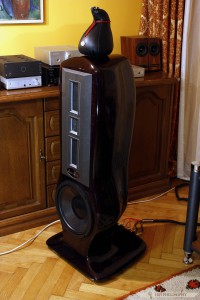 A nob for regulating trebles is hidden in one out of two bass-reflex channels of each loudspeaker. Thanks to that nob trebles are adjusted within a relatively wide range and as for me, the best option was setting them at a minimum. I have listened to it very carefully and I have no doubts as to my choice. Setting them to minimum does not mean that trebles were withdrawn or in any way softened. They had a phenomenal extension and on top of that, wonderful multi-dimentionality. As it is known, ribbon loudspeakers can reproduce high tones in an amazing way, however, it is not a simple matter to ensure that that occurs. In case of the tested system the trebles sphere and space were more-so of a show off in the performance. It does not mean though, that there was a shortage of base. It was taking a widespread position at the base of the band and in right moments rumbled powerfully when the entire band, just as the whole scene, created one perfect unity. It was clearly felt and I really enjoyed it myself.
A nob for regulating trebles is hidden in one out of two bass-reflex channels of each loudspeaker. Thanks to that nob trebles are adjusted within a relatively wide range and as for me, the best option was setting them at a minimum. I have listened to it very carefully and I have no doubts as to my choice. Setting them to minimum does not mean that trebles were withdrawn or in any way softened. They had a phenomenal extension and on top of that, wonderful multi-dimentionality. As it is known, ribbon loudspeakers can reproduce high tones in an amazing way, however, it is not a simple matter to ensure that that occurs. In case of the tested system the trebles sphere and space were more-so of a show off in the performance. It does not mean though, that there was a shortage of base. It was taking a widespread position at the base of the band and in right moments rumbled powerfully when the entire band, just as the whole scene, created one perfect unity. It was clearly felt and I really enjoyed it myself.
Another excellent issue was the way measures of reverberation were balanced. Perfection. There was zero of it in the recordings, so appropriately for the name of loudspeakers, and it should have been somewhere there – in both sacral and electronic music – it would vigoriously show and played the main role. It resulted in an excellent atmosphere, completely different depending on recordings, it all created a beautiful refreshing change from the usual situation present during the Audio Show, where the system would add extra reverb to everything, or simply there was no reverb at all.
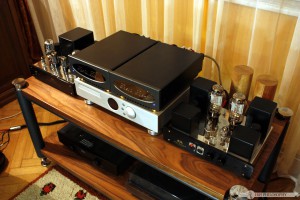 As for general remarks – the sound was not prolonged. It sounded fast and was cut as evenly as a lawn. However, when natural long sounds came, they were presented in their whole length. There was also no extra air pumped. At the Audio Show, especially in that aspect, famous Sonus Fabera loudspeakers failed to pass, whereas in case of Zetas it did not take place. They presented true naturality, and the winds were reproduced just fantastically with a large measure of gust and their own features.
As for general remarks – the sound was not prolonged. It sounded fast and was cut as evenly as a lawn. However, when natural long sounds came, they were presented in their whole length. There was also no extra air pumped. At the Audio Show, especially in that aspect, famous Sonus Fabera loudspeakers failed to pass, whereas in case of Zetas it did not take place. They presented true naturality, and the winds were reproduced just fantastically with a large measure of gust and their own features.
It is also important to mention that the sound system based on Zetas very clearly scaled the quality of performed recordings. It is not a surprise in the situation where I have described it as playing naturally. Since nothing was beautified, and at the same time it presented generally excellent level, it could not have been any other way. Not only did it differentiate the teachnical background itself – any noises, colour saturation, number of details, depth of sound – but also the lighting. Some recordings were completely bright, while others entirely dark. In other words, it was transparent.
The Sound
With ASL Twin-Head and Zeta Zeropower end bits
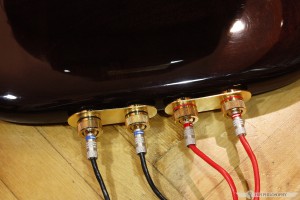 On the next day I had reached to the silver box in order to get two monoblocks made by Zeta itself. They are neither specially large, nor heavy. Each is more less the size of Croft and of similar weight, only slightly taller and heavier. They owe their height to the radiators placed at the bottom, and the weight to that mysterious content, which probably has not been seen by anyone so far. The producer defines them as analog meaning such, that are completely free from the aliasing numerousity of the signal, about which I have written in my preface. I have seen a discussion on the internet on that aspect because according to an opponent we are not dealing here with analog amplifiers, but with so called D class, meaning quite the opposite – digital ones. It is not my intention to conduct some kind of lecture debate here, neither is it to solve the analog – digital disagreement. The truth is, that after switching the monoblocks on, of which every single one according to the producer posesses the power of 1,175 kW, the electricity meter barely sped up, neither did the fuses pop, as it used to happen occasionally during starting Accuphase A-200 monoblocks. Still, mysterious boxes turned out to have been working and the music began to flow.
On the next day I had reached to the silver box in order to get two monoblocks made by Zeta itself. They are neither specially large, nor heavy. Each is more less the size of Croft and of similar weight, only slightly taller and heavier. They owe their height to the radiators placed at the bottom, and the weight to that mysterious content, which probably has not been seen by anyone so far. The producer defines them as analog meaning such, that are completely free from the aliasing numerousity of the signal, about which I have written in my preface. I have seen a discussion on the internet on that aspect because according to an opponent we are not dealing here with analog amplifiers, but with so called D class, meaning quite the opposite – digital ones. It is not my intention to conduct some kind of lecture debate here, neither is it to solve the analog – digital disagreement. The truth is, that after switching the monoblocks on, of which every single one according to the producer posesses the power of 1,175 kW, the electricity meter barely sped up, neither did the fuses pop, as it used to happen occasionally during starting Accuphase A-200 monoblocks. Still, mysterious boxes turned out to have been working and the music began to flow.
Monoblocks look very nice; their cases are elegant and in front there are large brand logo plaques, and at the back, each has a socket under a little flap, one for each monoblock (as it usually takes place) RCA and XLR. There is a power socket for a simple reason that no one has ever invented monoblocks operated on cosmic radiation so there is the main switch. A set of switches for connecting bi-wiring loudspeakers is attached to that, without which it would be rather hopeless even for the least provided audiophile conditions. Radiators located at the bottom are made of copper, their cases are greyish, iridescent towards blue, and plaques are elyptical and shiny.
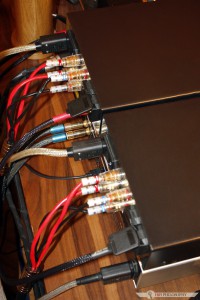 Not without difficulty those two monoblocks managed to fit on Cairn and the listening could begin.
Not without difficulty those two monoblocks managed to fit on Cairn and the listening could begin.
With some anxiety I switched it on. The home electrical plant dashboard did not explode despite 2,3 kW load, and the elecrtricity meter almost did not move. I like those analog end power bits, no kidding.
The meter barely moved and still the loudspeakers received enormous amplifying and in relevance to Croft became different. The whole pleiad of that distinctness fell over me immediately and its brightest points was greater smoothness, increased energy, stronger base and warmest sound. Also the space along with that dosage of energy became more distinct, filling the whole room.
I do not really care much whether such amplifiers will be called analog or digital, neither do I care whether Zeta’s monoblocks are constructed like the NuForce digital amplifier, or maybe basically different. The truth is, that both amplifiers can be characterized by great smoothness of the sound, although at the same time I have to admit, that after last year’s and present Audio Show listenings, at home they are an ideal choice for Zeta loudspeakers. Priced at 24 thousand PLN per pair, they seem to be a bargain because for exact same quality of sound others want many times more. One single and not any longer produced Croft also managed well, even though is was much cheaper (800 GBP); however it posessed one noticeable flaw – it gave definitely less base.
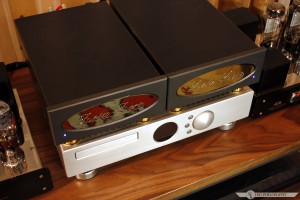 And that is certailny difficult to forgive because in that aspect Zetas are really capable of doing extremely well. Therefore during listening to both rock, and great symphony, their base touched my chest so forcefully that I became worried about my electrocardiogram and upcoming ventricular fibrillation. (I am just kidding, really).
And that is certailny difficult to forgive because in that aspect Zetas are really capable of doing extremely well. Therefore during listening to both rock, and great symphony, their base touched my chest so forcefully that I became worried about my electrocardiogram and upcoming ventricular fibrillation. (I am just kidding, really).
The Sound
With ASL Twin-Head and Zeta Zero power end bits cont.
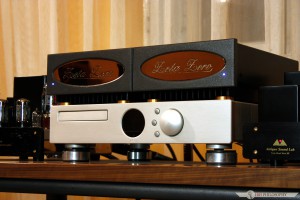 After connecting monoblocks my last year’s memories returned immediately, it was when I was comparing different sounds at the Audio Show, and I remembered Zetas seemed to me most musical, even more musical than a phonograph, which I though was thanks to the signal received from the Accuphase DP-700 being exceptionally musical as for digital source. Now I know that it was not the case because Zeta monoblocks are most musical first of all, and then, of course, the loudpeakers as well. Deprived of its own warmth and impressing only with capacitors, the Black Gate Cairn player became completely surrounded by the sound, and wrapped in the warmth of analog blanket, from under which the great energy was generated, as if somebody held a dragon under there. Dear Lord, how did that rumble! The whole room became shaky, I had to move my seat one meter back and just indulge, indulge, and indulge.
After connecting monoblocks my last year’s memories returned immediately, it was when I was comparing different sounds at the Audio Show, and I remembered Zetas seemed to me most musical, even more musical than a phonograph, which I though was thanks to the signal received from the Accuphase DP-700 being exceptionally musical as for digital source. Now I know that it was not the case because Zeta monoblocks are most musical first of all, and then, of course, the loudpeakers as well. Deprived of its own warmth and impressing only with capacitors, the Black Gate Cairn player became completely surrounded by the sound, and wrapped in the warmth of analog blanket, from under which the great energy was generated, as if somebody held a dragon under there. Dear Lord, how did that rumble! The whole room became shaky, I had to move my seat one meter back and just indulge, indulge, and indulge.
Such a sound we had never had before – anounced the junior – nodding his head with appreciation, and then began playing one rock piece after another, and I was listening to it all from my second row. A strip of good stereophonics became wider and without any problem it was possible to listen while seated even three people beside one another, and the things happening in that strip were just magnificient. In comparion to Croft the sound had been enriched. The variety of flavours was wider, just as if you took a higher class of wine, and the dynamic jumps underwent further enforcement. I played binatural records which contained extremely low bands as well as natural, dynamic passages without any compensation. The system took it all without even the slightest damage. What is more, the lowest elements turned out to be most spectacular. I played (or rather my son played) the famous Led Zeppelin drums solo from Moby Dick and not only was is perfectly heard when John Bonhan plays with his sticks and when he used his hands, but what is more important, his hands became perfectly visible, materializing their picture in a purely develish manner. Not less impressive was the measure with which the system could individualize vocals. For the first time since very, very long, and maybe just for the first time at all, I heard the ingredients which had not been present in AKG K1000. Probably thanks to monoblocks, but what does it matter now? I used to listen through Stax SR-009 headphones powered by three times the price Resteka monoblocks and I can say that I heard nothing new in comparison to my own system.
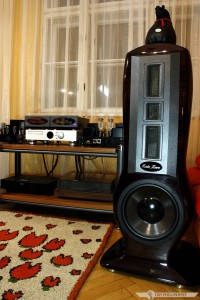 It truly played marvelously, but with analogical quality. Here, however, some individualistic features were displayed more thoroughly and comparing and generalizing it has to be admitted, that the system could much better differentiate the recordings and extract more unique features from them.
It truly played marvelously, but with analogical quality. Here, however, some individualistic features were displayed more thoroughly and comparing and generalizing it has to be admitted, that the system could much better differentiate the recordings and extract more unique features from them.
I sat there until three a.m. thanking God, or maybe some other Higher Matter, that no one lived below, under me, so that I could let myself go all the way. High, concert- like levels of sound volume played on Zetas have an amazing outburst and a phenomenal viewing of the performance. Viewing – that is right, exactly viewing – for whether your eyes be closed or opened, you can see with the eyes of performers and they are visible, whether you want it or not. That is why you can call it a picture and sound performance, just as always, while listening to a perfect device, only not always is it so overpowering, or rather almost never is.
When you look at it from the other side – with an eye of a critic – there were two things needing improvement. If it was me who would use it daily, I would lower the temperature. It is nothing difficult. Instead a Harmoniks interconnector, connected between the monoblocks and a Twin-Head, it would be better to use a Fadel or a Tara. And if it was meant to be used by someone who is rather wealthy, or if I was the one (meaning well off), it would be advised to reach for a source being able to find more details in the recording and to put more emphasis on the dynamics. In the first place, shared Metronome, which at the battlefield was even better than shared Accuphade comes to my head. But dCS or Reimyo would also probably do very well.
Summary
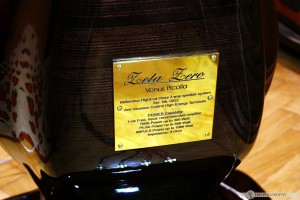 Summaries are rarely free from expressions „yes, but”, or „no, alhough”. It is rare, because it does not often happen that one can witness such a high class of sound, even if it involves a professional critic and regular audio displays goer. In context of the last Audio Show I can easily say that it needed fingers from both my hands to count systems present there such of a similar quality, and at the same time with no exception, sources playing there were dozens of times more expensive than the one I am writing about. Because even if a laptop was used as a source still DAC and its surroundings would cost as much as a car or not much less.
Summaries are rarely free from expressions „yes, but”, or „no, alhough”. It is rare, because it does not often happen that one can witness such a high class of sound, even if it involves a professional critic and regular audio displays goer. In context of the last Audio Show I can easily say that it needed fingers from both my hands to count systems present there such of a similar quality, and at the same time with no exception, sources playing there were dozens of times more expensive than the one I am writing about. Because even if a laptop was used as a source still DAC and its surroundings would cost as much as a car or not much less.
And here, the excellent specification of the Zeta system appears: those monoblocks and loudspeakers do not need any extraordinary source. Their analog smoothness, their fantastic realizm and huge power make them capable of building a quality peak even in front of a medium quality player and its weaknesses will become invisible. A skilled ear can technically find some traces of intricacies; minimal scratches and flaws, but these are really just trifles, and therefore even someone as picky as I will not be able to say that they can feel those flaws and that they disturb him in listening. This music is just too captivating, being just the music itself, the objective and the end of the road for every audiophile. It can be described in many technical manners, just as I have done above, or just in a simple, emotional way. I listen to music almost every day, even if I do not feel like it, I still have to. That is my job. As an effect I am obliged to break my internal stubborness and anger coming from the fact that most of the stages described by me play worse than my own. And so it happened yesterday that I had to travel far and that day was a day wasted, without me listening to Zetas in my living room. I was very annoyed and felt sorry about it.
– Such recommendation.
I will add something extra at the end. Something thought-provoking. In case of Zetas, similarly as in case of Oslo loudspeakers from Ancient Audio, after praising them in my reports from the Show, I came across quite a massive, even as for my experience, very surprising increase of criticizm at the internet discussion boards. Those bollocks, because I cannot name it any other thing, evidently presented features of planned propaganda whose aim was to lessen the market strength of the subject. In reference to Oslo it was just a regular talk without sense and not supported by any logical argumentation, operating only with invectives but in reference to Zetas, some „arguments” appeared there. Those pointless comments about Zetas claimed, for example, that their base was hopeless and that there was a „hole” between mid and high tones. Their silly argumentation was at the intelectual level of football stadium hooligans, when it is obvious which team is the best in the world even if it scored the last place in the third league, and this time, I know which team was mentioned here. Instead picking on base in Zetas I propose that they should come up with a legislatory initiative banning low frequencies altogether. It would both be decent and wise. As for the second issue, I have returned to the hearings thinking that maybe it was just my imagination that Zeta band was evened. I am skipping the fact that the mentioned above critic must have heard that in Zetas both middle and the top of band were served by the same and only set of ribbon loudspeakers. Nevertheless if there is no coherence but some strange hole, then I can invite those who argue for joint hearing and let them point out where exactly that hole lies, because I would be greatly happy to be able to see it, and admire how wonderful ears others have.
Those guys must have microscopes inside their ears and therefore can see quantum holes. Geniuses, damn it. But the peak of that was, when another gentleman claimed no more no less but that Zetas „squeek, scratch and hiss”. This kind of dimention could only be entered after a powerful drug shot or while being terribly hung over. Or simply it was their way of kicking someone’s ass, for the simple fact that he is not one of ours.
In points:
Advantages
• Music, music, music.
• Fantastic overall level.
• Phenomenal trebles.
• Very strong base support.
• Extremely rarely observed individualization of human voices.
• Complete band cohesion.
• Complete stage cohesion.
• Speed and drive.
• Ease of driving.
• Enormous power with own monoblocks,
• Also increased thanks to extra portion of music.
• Zero distortions even during very high levels of sound volume.
• Natural advantages of ribbon loudspeakers.
• Perfect construction.
• Wonderful appearance.
• Tasteful styling.
• They act as room decoration.
• Unique technology.
• The only ones of the kind in the world.
• The highest quality of materials used for them.
• Loudspeakers’ cables included in set.
• Trebles’ range regulation.
• They can be played even in small rooms,
• Or in very spacious ones.
• Top notch dedicated amplifier and power end bits.
• Attached to the set, they successfully conceal flaws in the sound source.
• Worldwide known.
• Polish production, servicing and distribution.
• Two years warranty.
Drawbacks and objections
• Unfortunately they are not cheap.
• Some technical aspects remain only the producer’s secret.
• They noticeably expose the quality of recordings (Which is a natural consequence of this quality range.)
• Item is manufactured by a small company (Provided that someone likes the big producers.)
Zeta Zero Web Page
Technical details:
Zeta Zero Venus Picolla:
• Power: RMS/Music/Impulse – 1 sec (Watt) 300/500/1000W
• Carrying band: (-12 dB) 18 Hz – 50 kHz
• Average effectiveness: > 92 dB
• Maximal SPL pressure: ≥ 130 dB.
• Impedance: 4 Ω.
• Reccommended amplifier: 8 – 1000 W
• Recommended size of the room for listening: 12 – 80 msq.
• Dimentions: 108 x 47 x 48 cm.
• Weight: 65 kgs.
• Type of loudspeaker column: Passive.
• Overload registrating computer.
• Base loudspeaker protection.
• Ribbon loudspeakers protection.
• Connection type: Bi-wiring
• Membranes cooling system.
• Subwoofer: Carbon 12 inch.
• Two middletone ribbon loudspeakers.
• Single ribbon treble loudspeaker.
• Price: 61 500 PLN.
Monoblocks:
• Effective power (max) – 1175 Watt RMS/4Ω.
• Damping coefficient: 1600 / 8 Ω.
• THD: 0,007% with 1 Watt; 0,2% with 1000 Watt.
• Dynamics: 118 dB.
• Efficiency: 78%.
• Carrying band: 5 Hz – 38 kHz (8 Ω) – 3 dB (intentionally limited).
• Weight: 8 kg.
• Dimentions: 12 x 22 x 33 cm.
• Price: 24 600 PLN per pair.










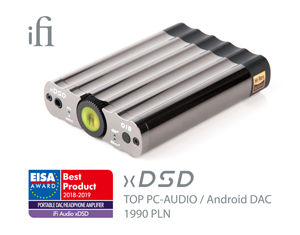


Helpful information. Fortunate me I discovered your website
by accident, and I’m shocked why this coincidence did not came about
earlier! I bookmarked it.
Great sound plus fantastic design. No competiton in the style. wow!!!